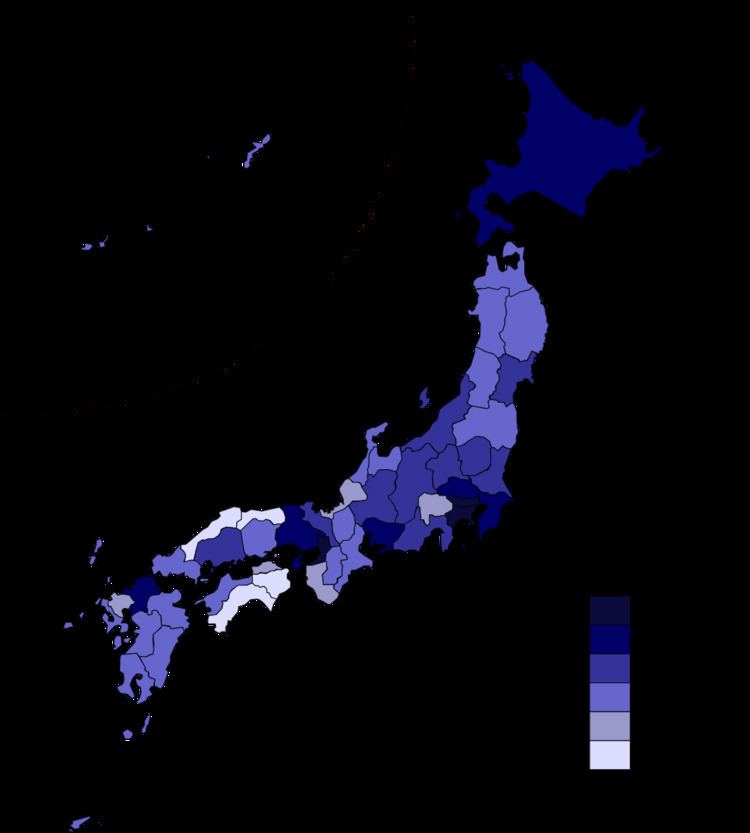 | ||
This is a list of Japanese prefectures by population.
Contents
- Prefectures of Japan ranked by population as of October 1 2015
- Historical demography of prefectures of Japan
- 1948 to 2010
- 1920 to 1947
- 1884 to 1918
- 1872 to 1883
- 1868 to 1871
- References
For details of administrative divisions of Japan, see Prefectures of Japan.
Prefectures of Japan ranked by population as of October 1, 2015
Figures here are according to the official estimates of Japan as of October 1, 2011, except for the census population held on October 1, 2010. Population is given according to the de jure population concept for enumerating the people. That is, a person was enumerated at the place where he or she usually lived, and was counted as the population of the area including the place. Ranks are given by the estimated population as of October 1, 2011.
Historical demography of prefectures of Japan
Population before 1920 was calculated based on information of family registries (戸籍, koseki), while door-to-door censuses have been held every 5 years as of October 1 since 1920 in Japan except for the year of 1945.
As for prefectural population before 1945, prefectures that constituted official Japan Proper or Mainland Japan (内地, naichi, inner lands) are only given. Karafuto Prefecture (樺太府, Karafuto-fu) or Southern Sakhalin was officially incorporated into Japan Proper since March 26, 1943 until the end of the World War II, while Taiwan, Kwantung Leased Territory, Korea and South Pacific Mandate were treated as exterior territories (外地, gaichi, outer lands). At the end of war, Japan lost possessions of Southern Sakhalin (Karafuto-fu), Kuril Islands (part of Hokkaidō), Ogasawra Islands (part of Tōkyō-to), Amami and Tokara Islands (part of Kagoshima-ken), Daitō Islands and Ryukyu Islands (Okinawa-ken). For the population of the colonies of the former Empire of Japan, see Demographics of Imperial Japan.
1948 to 2010
Population in the following table is given according to the de jure population concept for enumerating the people.
1920 to 1947
Population in the following table is given according to the de facto population concept for enumerating the people.
1884 to 1918
Population in the following tables is given according to the A-type de facto population concept for enumerating the people, based on koseki registration systems.
1872 to 1883
Population in the following table is given according to the original family registries (本籍, honseki) population concept for enumerating the people, based on koseki registration system.
1868 to 1871
Several demographic data remain for three urban prefectures (府, fu]),(i.e. Kyōto-fu, Ōsaka-fu and Tōkyō-fu), 266 domains (藩, han), 40 prefectures (県, ken) and one commission (使, shi) (i.e. Kaitaku-shi only in Hokkaidō) that existed for short time between Meiji Restoration and the Abolition of the han system, though not thoroughly surveyed. Prefectural system was only introduced to imperial territories (天領, tenryō) which the Meiji government gained from Tokugawa shogunate or the revolted feudal lords (大名, daimyō), while many areas still belonged to local lordship governments. The table below summarizes demographic data from three sources.
Source': (ref.1): Table of households for shi, fu and ken (Meiji-shi-yō).
Statistical data were given as of August 29, 1871 (29th day of the 8th month, Meiji 4) for (1), as of February 2, 1869 (1st day of the 1st month, Meiji 2), for (2) or uncertain for (3), although all these populations seemed to be collected from several koseki populations surveyed in 1869 and 1870. Naotarō Sekiyama noted that the population of Japan as of August, 1870 (7th month, Meiji 3) was 32,794,897 (Kinsei Nihon jinkō-no kenkyū (Study of the Population of Japan in the Early Modern Period) (1948)).
It is quite apparent that the above demographic data contain many textual errors, but could not be corrected because the original unpublished reports preserved at the office of the Ministry of Interior of Japan were burned by a fire after the 1923 Great Kantō earthquake.
For demographic data during the Edo period, see Demographics of Japan before Meiji Restoration.
